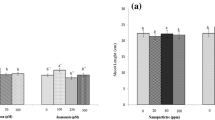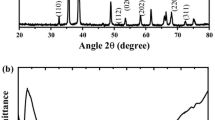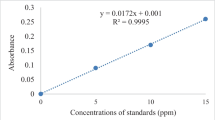Abstract
The 2-(2-phenylethyl) chromones are the main characteristic constituents for the fragrance and pharmacological activities of agarwood. Iron and methyl jasmonate (MeJA) are two important elicitors that affect the production of secondary metabolites in plants. With the aim to evaluate the response of eight 2-(2-phenylethyl)chromones constituents of Aquilaria sinensis to ferrous sulfate (FeSO4) and MeJA treatment, the content of eight 2-(2-phenylethyl)chromones in A. sinensis callus tissues treated with 0%, 0.4%, and 0.8% FeSO4 as well as 0 μmol/L, 50 μmol/L, 100 μmol/L, and 200 μmol/L MeJA for 3, 7, and 15 days were analyzed using liquid chromatograph mass spectrometry. The results showed that the content of eight 2-(2-phenylethyl)chromones were significantly affected under the FeSO4 and MeJA treatment. The content of 2-(2-phenethyl)chromones, except for 4'-methoxy isoagarotetrol, was highest at 0.8% FeSO4 treatment for 7 days. For the MeJA treatment, 6-hydroxy-2-(2-phenylethyl)chromone and 6,7-dimethoxy-2-(2-phenylethyl)chromone were highest at 50 μmol/L MeJA for 7 days, while the content of agarotetrol, 4'-methoxy isoagarotetrol, isoagarotetrol, (5S,6S,7S,8R)-8-chloro-5,6,7-trihydroxy-2-phenylethyl-5,6,7,8-tetrahydro-4H-chromen-4-one, 2-(2-phenylethyl)chromone, and 2-[2-(4-methoxyphenyl)ethyl] chromone were significantly increased at 200 μmol/L MeJA for 7 days. Compared with MeJA treatment, FeSO4 is more likely to induce 2-(2-phenylethyl)chromones in A. sinensis. Our results provide a useful information for large-scale commercial production of 2-(2-phenylethyl)chromones.
Key message
Ferrous sulfate and MeJA as elicitors can improve the eight 2-(2-phenylethyl)chromones contents in A. sinensis calli, and FeSO4 is more likely to induce 2-(2-phenylethyl)chromones.







Similar content being viewed by others
Data availability
This study ensures complete transparency and accessibility of all the data generated or analyzed. The manuscript contains all the necessary information, and upon reasonable request, the corresponding author will promptly provide the data. Feel free to reach out to the corresponding author for any inquiries regarding the data from this study.
References
Ahammed GJ, Wu MJ, Wang YQ, Yan YR, Mao Q, Ren JJ, Ma RH, Liu AR, Chen SC (2020) Melatonin alleviates iron stress by improving iron homeostasis, antioxidant defense and secondary metabolism in cucumber. Sci Hortic 265:109205. https://doi.org/10.1016/j.scienta.2020.109205
Budzyńska S, Siwulski M, Gąsecka M, Magdziak Z, Kalač P, Niedzielski P, Mleczek M (2022) Biofortification of three cultivated mushroom species with three iron salts-potential for a new iron-rich superfood. Mol 27:2328. https://doi.org/10.3390/molecules27072328
Chen Y, Yan TT, Li HD, Liao YF, Zhang YG, Hu ZK, Li GY (2022) Structure and chemical characteristics of lyuqinan agarwood from huidong. Chin J Wood Sci Technol 36(1):49–56. https://doi.org/10.12326/j.2096-9694.2021059. (In Chinese)
De Gara L, Locato V (2018) Methods in molecular biology vol 1743: programmed cell death in plants. Spring Street, New York. https://doi.org/10.1007/978-1-4939-7668-3
Dixon RA (2001) Natural products and plant disease resistance. Nature 411(6839):843–847. https://doi.org/10.1038/35081178
Dong XJ, Gao BW, Feng YY, Liu X, Wang J, Wang JL, Tu PF, Wang XH, Shi SP (2018) Production of 2-(2-phenylethyl)chromones in Aquilaria sinensis calli under different treatments. Plant Cell, Tissue Organ Cult 135:53–62. https://doi.org/10.1007/s11240-018-1442-5
Ebeed HT, El-helely A (2021) A programmed cell death in plants: insights into developmental and stress-induced cell death. Curr Protein Pept Sci 22(12):873–889. https://doi.org/10.2174/1389203722666211109102209
Fan MY, Yang W, He M, Li YJ, Peng ZY, Wang GC (2022) Occurrence, synthesis and biological activity of 2-(2-phenyethyl)chromones. Eur J Med Chem 237:114397. https://doi.org/10.1016/j.ejmech.2022.114397
Geyter ND, Gholami A, Goormachtig S, Goossens A (2012) Transcriptional machineries in jasmonate-elicited plant secondary metabolism. Trends Plant Sci 17(6):349–359. https://doi.org/10.1016/j.tplants.2012.03.001
He ML, He F, Meng JL, Zhang HY, Gao XX, Yan HJ (2013) Effect of three elicitors on inducible formation of 2-(2-phenylethyl)chromones in cell suspension cultures from root of Aquilaria sinensis. Chin Tradit Pat Med 35:7. https://doi.org/10.3969/j.issn.1001-1528.2013.07.003
Huang JQ, Liao YC, Chen HJ, Zhang Z (2017) Chemical solution is an efficient method to induce the formation of 2- (2-phenylethyl) chromone derivatives in Aquilaria sinensis. Phytochem Lett 19:64–70. https://doi.org/10.1016/j.phytol.2016.12.004
Huo HX, Zhu ZX, Song YL, Shi SP, Sun J, Sun H, Zhao YF, Zheng J, Ferreira D, Zjawiony JK, Tu PF, Li J (2018) Anti-inflammatory dimeric 2-(2-phenylethyl)chromones from the resinous wood of Aquilaria sinensis. J Nat Prod 81(3):543–553. https://doi.org/10.1021/acs.jnatprod.7b00919
Ito M, Ken-ichiro O, Yagura T, Honda G, Kiuchi F, Shimada Y (2005) Induction of sesquiterpenoid production by methyl jasmonate in Aquilaria sinensis cell suspension culture. J Essent Oil Res 17(2):175–180. https://doi.org/10.1080/10412905.2005.9698867
Kobayashi T, Nozoye T, Nishizawa NK (2019) Iron transport and its regulation in plants. Free Radicals Biol Med 133:11–20. https://doi.org/10.1016/j.freeradbiomed.2018.10.439
Li W, Cai CH, Dong WH, Guo ZK, Wang H, Mei WL (2014) 2-(2-Phenylethyl)chromone derivatives from Chinese agarwood induced by artificial holing. Fitoterapia 98:117–123. https://doi.org/10.1016/j.fitote.2014.07.011
Li W, Chen HQ, Wang H, Mei WL, Dai HF (2021) Natural products in agarwood and Aquilaria plants: chemistry, biological activities and biosynthesis. Nat Prod Rep 38:528–565. https://doi.org/10.1039/D0NP00042F
Liu J, Xu YH, Zhang Z, Wei JH (2014) Hydrogen peroxide promotes programmed cell death and salicylic acid accumulation during the induced production of sesquiterpenes in cultured cell suspensions of Aquilaria sinensis. Funct Plant Biol 42(4):337–346. https://doi.org/10.1071/FP14189
Lucena JJ, Hernandez-Apaolaza L (2017) Iron nutrition in plants: an overview. Plant Soil 418:1–4. https://doi.org/10.1007/s11104-017-3316-8
Marschnert H, Kirkby EA, Engels C (1997) Importance of cycling and recycling of mineral nutrients within plants for growth and development. Bot Acta 110(4):265–273. https://doi.org/10.1111/j.1438-8677.1997.tb00639.x
Naziz PS, Das R, Sen S (2019) The scent of stress: evidence from the unique fragrance of agarwood. Front Plant Sci 10:840. https://doi.org/10.3389/fpls.2019.00840
Okudera Y, Ito M (2009) Production of agarwood fragrant constituents in Aquilaria calli and cell suspension cultures. Plant Biotechnol 26(3):307–315. https://doi.org/10.5511/plantbiotechnology.26.307
Sembdner G, Parthier B (1993) The biochemistry and the physiological and molecular actions of jasmonates. Annu Rev Plant Biol 44(1):569–589. https://doi.org/10.1146/annurev.pp.44.060193.003033
Shibata S, Sugiyama T, Uekusa Y, Masui R, Narukawa Y, Kiuchi F (2020) Five new 2-(2-phenylethyl)chromone derivatives from agarwood. J Nat Med 74(3):561–570. https://doi.org/10.1007/s11418-020-01410-z
Sugiyama T, Narukawa Y, Shibata S, Masuib R, Kiuchi F (2016) New 2-(2-phenylethyl)chromone derivatives and inhibitors of phosphodiesterase (PDE) 3A from agarwood. Nat Prod Commun 11(6):795–797. https://doi.org/10.1177/1934578X1601100624
Takamatsu S, Ito M (2021) Factors affecting 2-(2-phenylethyl)chromones in artificial agarwood. J Nat Med 76:321–330. https://doi.org/10.1007/s11418-021-01555-5
Tan CS, Isa NM, Ismail I, Zainal Z (2019) Agarwood induction: current developments and future perspectives. Front Plant Sci 10:122. https://doi.org/10.3389/fpls.2019.00122
Thomine S, Vert G (2013) Iron transport in plants: better be safe than sorry. Curr Opin Plant Biol 16(3):322–327. https://doi.org/10.1016/j.pbi.2013.01.003
Wang S, Yu ZX, Wang CH, Wu CM, Guo P, Wei JH (2018a) Chemical constituents and pharmacological activity of agarwood and Aquilaria plants. Mol 23:342. https://doi.org/10.3390/molecules23020342
Wang XH, Dong XJ, Feng YY, Liu X, Wang JL, Zhang ZX, Li J, Zhao YF, Shi SP, Tu PF (2018b) H2O2 and NADPH oxidases involve in regulation of 2-(2- phenylethyl)chromones accumulation during salt stress in Aquilaria sinensis calli. Plant Sci 269:1–11. https://doi.org/10.1016/j.plantsci.2018.01.002
Wang XH, Gao BW, Nakashima Y, Mori T, Zhang ZX, Kodama T, Lee YE, Zhang ZK, Wong CP, Liu QQ, Qi BW, Wang J, Li J, Liu X, Abe I, Morita H, Tu PF, Shi SP (2022) Identification of a diarylpentanoid-producing polyketide synthase revealing an unusual biosynthetic pathway of 2-(2-phenylethyl) chromones in agarwood. Nat Commun 13:348. https://doi.org/10.1038/s41467-022-27971-z
Wei SY, Hu DB, Xia MY, Luo JF, Yan H, Yang JH, Wang YS, Wang YH (2021) Sesquiterpenoids and 2-(2-Phenylethyl)chromone derivatives from the resinous heartwood of Aquilaria sinensis. Nat Prod Bioprospec 11:545–555. https://doi.org/10.1007/s13659-021-00313-0
Xu YH, Zhang Z, Wang MX, Wei JH, Chen HJ, Gao ZH, Sui C, Luo HM, Zhang XL, Yang Y, Meng H, Li WL (2013) Identification of genes related to agarwood formation: transcriptome analysis of healthy and wounded tissues of Aquilaria sinensis. BMC Genomics 14:227. https://doi.org/10.1186/1471-2164-14-227
Yan TT, Yang S, Chen Y, Wang Q, Li GY (2019) Chemical profiles of cultivated agarwood induced by different techniques. Mol 24(10):1990. https://doi.org/10.3390/molecules24101990
Yang DL, Mei WL, Zeng YB, Guo ZK, Zhao YX, Wang H, Zuo WJ, Dong WH, Wang QH, Dai HF (2013) 2-(2-Phenylethyl)chromone derivatives in Chinese agarwood “Qi-Nan” from Aquilaria sinensis. Planta Med 79:1329–1334. https://doi.org/10.1055/s-0033-1350647
Yang L, Yang YL, Dong WH, Li W, Wang P, Cao X, Yuan JZ, Chen HQ, Mei WL, Dai HF (2019) Sesquiterpenoids and 2-(2-phenylethyl)chromones respectively acting as α-glucosidase and tyrosinase inhibitors from agarwood of an Aquilaria plant. J Enzyme Inhib Med Chem 34(1):853–862. https://doi.org/10.1080/14756366.2019.1576657
Yang ZL, Zhao J (2017) Qualitative and quantitative analysis of icariin analogues in Epimedium koreanum by UPLC-Q-TOF MS. J Chin Mass Spectrom Soc 38(1):19–29. https://doi.org/10.7538/zpxb.2017.38.01.0019.(InChinese)
Zhang ZX, Wang XH, Yang WQ, Wang J, Su C, Liu X, Li J, Zhao YF, Shi SP, Tu PF (2016) Five 2-(2-phenylethyl)chromones from sodium chloride-elicited Aquilaria sinensis cell suspension cultures. Molecules 21(5):555. https://doi.org/10.3390/molecules21050555
Zhao T, Zhou Y, Li WY, Ma XY, Zhan RT, Chen WW (2019) Experimental induction of 2-(2-phenylethyl) chromone in aerial roots of Aquilaria sinensis. Pak J Bot 51(5). https://doi.org/10.30848/pjb2019-5(16)
Zhao T, Zhou Y, Tang Y, Ma XY, Zhan RT, Chen WW (2017) Programmed cell death in rooting cells in relation to 2-(2-phenylethyl)chromone in Aquilaria sinensis. North Hortic 207:157–162. https://doi.org/10.11937/bfyy.20170169
Acknowledgements
This work was supported by the Special Funds for Central Public-Interest Scientific Institution Public Welfare Projects (CAFYBB2021QD003).
Funding
The authors have not disclosed any funding.
Author information
Authors and Affiliations
Contributions
Wenli Wu: Investigation, Formal analysis, Visualization, Writing—original draft; Xiaochen Sun: supervision; Iain Wilson: Writing—review & editing; Luyuan Jiang: supervision. Xiaoyang Jiang: supervision; Fenjuan Shao: Investigation, Funding acquisition, Writing—review & editing; Deyou Qiu: supervision.
Corresponding author
Ethics declarations
Competing interests
All the authors declare no conflicts of interest.
Additional information
Communicated by Victor M. Jimenez
Publisher's Note
Springer Nature remains neutral with regard to jurisdictional claims in published maps and institutional affiliations.
Supplementary Information
Below is the link to the electronic supplementary material.
Rights and permissions
Springer Nature or its licensor (e.g. a society or other partner) holds exclusive rights to this article under a publishing agreement with the author(s) or other rightsholder(s); author self-archiving of the accepted manuscript version of this article is solely governed by the terms of such publishing agreement and applicable law.
About this article
Cite this article
Wu, W., Sun, X., Wilson, I. et al. Effects of ferrous sulfate and methyl jasmonate treatment on the content of 2-(2-phenethyl)chromones in Aquilaria sinensis. Plant Cell Tiss Organ Cult 156, 51 (2024). https://doi.org/10.1007/s11240-024-02683-y
Received:
Accepted:
Published:
DOI: https://doi.org/10.1007/s11240-024-02683-y




